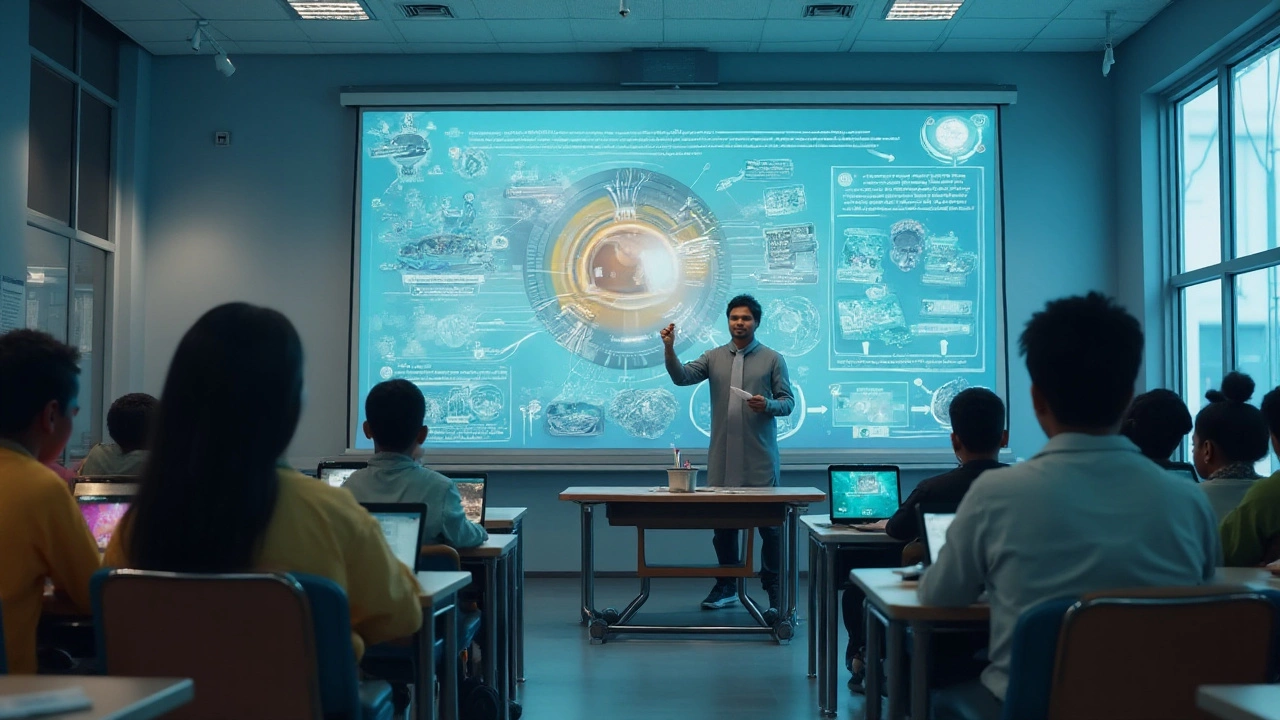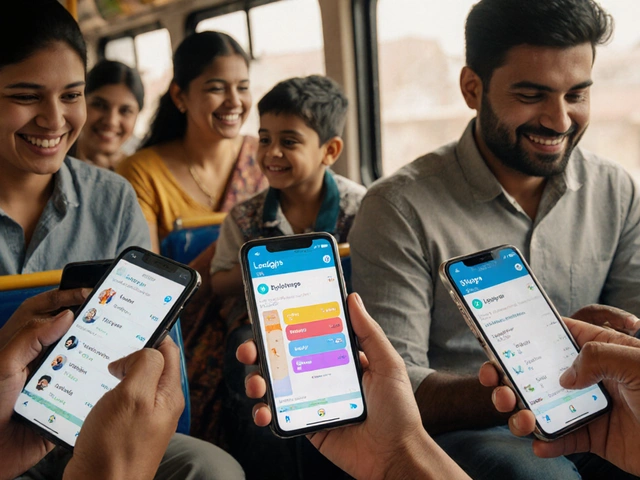As we stand on the cusp of educational transformation in 2025, the conversation about eLearning versus traditional classroom learning grows ever more compelling. Both methods offer distinct pathways to acquiring knowledge, each rich with its own set of opportunities and challenges.
eLearning revolutionizes education by granting learners a new degree of freedom and flexibility. Imagine being able to attend a lecture from your living room or tapping into a wealth of online resources at midnight. This digital approach empowers individuals to personalize their learning journey, fitting education into tight schedules effortlessly.
On the flip side, traditional classroom learning remains a gold standard for many, providing structured, face-to-face interactions with instructors and peers. These interactions often foster a sense of community, encouraging lively discussions and instant feedback, which some students find irreplaceable.
The question isn’t necessarily which is better, but rather which suits your personal learning style. By understanding their differences, you can make an informed choice that aligns with your goals and lifestyle. Both realms of learning offer unique advantages, crafting a rich tapestry of educational possibilities for learners worldwide.
- The Essence of eLearning
- Traditional Classroom Dynamics
- Understanding Flexibility in Learning
- Interactions: Digital vs. Face-to-Face
- Accessibility and Resources
- Which Learning Style Suits You?
The Essence of eLearning
In recent years, eLearning has emerged as a transformative force in the educational sphere, altering how knowledge is shared and absorbed across the globe. At its core, eLearning is the delivery of learning experiences and educational content through digital platforms, allowing learners to access a wealth of resources from virtually anywhere, at any time. This shift from traditional learning settings to digital environments has introduced not only a new level of accessibility but a personalized learning journey tailored to individual needs. The flexibility inherent in eLearning is often its most celebrated feature, letting students take charge of their own pace and schedule without the constraints of time and location.
This adaptability of eLearning doesn't just benefit the individual, but it also opens new avenues for educators and institutions. Instructors can create engaging and interactive content using multimedia tools, such as videos, podcasts, and interactive quizzes, which appeal to different learning styles. This capability not only enriches the user's experience but also enhances the effectiveness of teaching. Moreover, eLearning platforms often incorporate real-time analytics, giving educators insightful data about the learner's progress and pain points, enabling a more responsive teaching approach that can quickly address areas needing improvement. According to a report by the Global eLearning Market, the industry's growth rate is expected to increase by 14.6% CAGR by 2027, highlighting the growing acceptance and investment in this educational model.
While eLearning offers significant advantages, one cannot overlook its dependence on technology and the potential hurdles this creates. Reliable internet access, updated devices, and technological literacy are prerequisites to fully participate in an eLearning environment. These requirements can sometimes present challenges, especially in underdeveloped regions where infrastructure improvements are needed. Yet, despite these barriers, the opportunities eLearning brings continue to expand rapidly. Dr. John Odell in an interview with EdTech Magazine stated, "eLearning is not just a trend; it's becoming a staple in our education systems providing endless possibilities for all-kinds-of learners." Such insights highlight the anticipation and excitement that surround the continued evolution and refinement of eLearning methodologies.
Beyond accessibility and flexibility, eLearning also empowers individuals to curate their learning pathways through a rich array of courses and specializations available at students' fingertips. From professional development holdings to personal fulfillment endeavors, the diversity of topics covered in online courses is vast. Learners can explore new fields, gain skills demanded in job markets, or delve into hobbies, broadening their horizons and enhancing their skillset.The focus is not merely on earning certifications but truly understanding content, as digital platforms leverage gamification, peer-to-peer collaborations, and more to make learning both effective and enjoyable. By placing the control in the hands of learners, individuals can take ownership of their growth, paving the way for more innovation in the educational industry.
Traditional Classroom Dynamics
Traditional classroom learning has long been the cornerstone of education systems worldwide. In these settings, the classroom serves as more than just a place of instruction—it acts as a vibrant community where students and educators engage in a shared learning experience. The routine of arriving at a specific place at a scheduled time provides students with structure and a sense of discipline that mirrors many professional environments. This routine extends beyond the classroom walls, influencing how individuals manage their time and commitments. The architecture of learning in classrooms is designed to engage students not just intellectually but socially and emotionally as well. Through direct interaction with peers and teachers, students build crucial communication skills, experience real-time feedback, and participate in collaborative problem-solving activities.
The dynamics of the traditional classroom are also deeply rooted in its method of content delivery. Lectures are commonly coupled with immediate question-and-answer sessions, where students are encouraged to critically analyze material and discuss diverse viewpoints. This interactive manner of teaching helps solidify concepts more effectively, often with the support of tangible materials like books, whiteboards, and instructional tools that can be utilized during lessons. Even the physical placement of individuals in a classroom—rows, circles, or clusters—can significantly impact learning styles and participation levels. According to educational experts, such settings provide an environment conducive to developing social networks that are invaluable for personal growth and future professional endeavors.
Interestingly, the traditional classroom is evolving to integrate elements of modern technology to enhance learning experiences. Schools are increasingly equipped with digital facilities like smartboards and computer labs, bridging some of the gaps between traditional and electronic learning environments, yet maintaining the unique interactive elements that such settings foster. While some worry that the digital shift might dilute the intimate communication traditional classrooms are known for, many educators argue that technology can be blended seamlessly with time-tested teaching methods. Education expert John Hattie once stated,
"Teachers can use technology not just to replicate traditional teaching but to be the architects of powerful learning experiences."By harnessing technology’s potential, many classrooms are successfully striking a balance, resulting in unique hybrid models of instruction that cater to diverse learning preferences.
The traditional classroom has faced scrutiny, particularly regarding educational equity, access, and the ability to meet varying learning needs. Critics often cite limited personalization as one of the primary challenges, given that most curriculums aim to cater to an average learning speed, leaving some students in need of additional help or stimulation. Yet, the environment fosters a collective energy seldom found in isolated online experiences, making it a preferred choice for those who thrive on face-to-face interaction and immediate group feedback. The classroom serves as a microcosm of the broader society, where students learn not only subject matter but also social norms, cultural nuances, and skills needed to negotiate shared spaces. Traditional classrooms promote a sense of belonging and shared responsibility, instilling in students an appreciation for diverse perspectives and a sense of community involvement that has lifelong implications.

Understanding Flexibility in Learning
Flexibility in learning is a crucial factor when deciding between eLearning and traditional classroom learning. In today's fast-paced world, the ability to learn at your own pace and schedule is more valuable than ever before. One of the most significant advantages of eLearning lies in its adaptability. Students can access courses anytime, anywhere, and this convenience transforms education into a more inclusive experience. For busy professionals, parents, or students balancing multiple commitments, the flexibility of logging into a course at a time that suits them can be a game-changer. The digital landscape offers a wide array of platforms where learners can engage with material, participate in discussions, and complete assessments, making time zones and geographical locations irrelevant. This level of accessibility means education is no longer confined to the four walls of a traditional classroom.
In contrast, classroom learning adheres to a more fixed schedule. Classes often take place at set times with a predetermined syllabus, which can offer a sense of routine that some learners prefer. In this environment, direct interaction with the instructor and peers occurs in a structured manner, which can facilitate different styles of engagement and learning. For certain subjects, such as those requiring hands-on practice or immediate feedback, this can be particularly beneficial. However, it can be a double-edged sword. A rigid timetable might limit learners who have fluctuating work hours or personal commitments, making it harder to keep up without disruptions to their personal life. For instance, in a survey conducted in 2023, 68% of participants reported preferring eLearning over classroom settings primarily due to the ability to manage their educational pursuits alongside professional obligations.
The Technological Boost of Flexibility
Technology plays a pivotal role in enabling the flexibility that eLearning provides. Platforms abound with tools that personalize the learning experience, from AI-driven feedback systems to virtual classrooms that simulate real-world settings. Students can benefit from interactive sessions, quizzes, and multimedia presentations, which enhance engagement and retention. The asynchronous nature of many online courses allows learners to revisit lectures and materials as needed, reinforcing knowledge in a way that supports long-term retention. This method of instruction aligns well with the diverse learning speeds of students, as data from an educational study noted that students learn 40% faster on digital platforms due to video replay capabilities and flexible pacing.
"eLearning can provide a just-in-time learning opportunity that is adaptable to individuals’ daily lives, reducing barriers to access education," says Kevin Kruse, a respected author on educational technology.
Understanding these dynamics helps when choosing between the two. For instance, a student studying for a higher degree may find that the asynchronous delivery of content in an online course allows for balancing job responsibilities, whereas a younger student may benefit from the discipline and direct engagement of a physical classroom. Both forms have their places in today's educational ecosystem. So, whether you're drawn to the self-paced, on-demand nature of eLearning or the dynamic interaction of classroom environments, understanding what suits your lifestyle and needs will guide you to the most effective choice. With education continuously evolving, the flexibility in learning paths ensures a more inclusive and personalized way to nurture individual growth and lifelong learning.
Interactions: Digital vs. Face-to-Face
One of the most striking distinctions between eLearning and classroom learning lies in the nature of interactions. Digital platforms thrive on flexibility and accessibility, yet they often lack the tangible, immediate engagement available in a physical classroom. Imagine attending a virtual meeting: all participants are present, yet the conversation doesn't flow like it might around a shared table. This dynamic can create a unique set of opportunities and challenges, testing one's self-discipline and motivation. A well-designed online course can simulate certain aspects of face-to-face interaction via discussion forums, video calls, and collaborative projects.
However, compared with the occasional sensation of speaking into the void in an online lecture, the physical classroom counters with an environment steeped in immediacy and camaraderie. The gestures of a teacher, the whisper of a classmate, and shared laughter or intrigue play crucial roles in enhancing the learning experience. Classroom interactions encourage spontaneous questions and debates, heightening engagement. Educators can gauge and adapt to non-verbal cues, offering tailored support as needed. "In education, technology can be a wonderful tool, but it will never replace the natural connection found in a classroom environment," said Sir Ken Robinson, an influential advocate for educational reform.
I know many parents and teachers agree that nothing replaces the social learning that takes place in a classroom.
Data might suggest that while 80% of students enrolled in online courses enjoy self-paced learning, they also report missing out on instant, rich human interactions. A balance can be achieved, and some educational institutions are blending these modes to craft hybrid learning experiences. These initiatives offer structured, interactive digital spaces while preserving crucial aspects of physical presence. Both styles have uniquely defined interactivity, making them formidable choices depending on what a learner seeks: the detailed personal exchange an in-person session can facilitate, or the depth of digital discourse accessible at any hour. As digital tools evolve, we observe the narrowing gap between these two, yet a virtual high-five still doesn't match the warmth of physical applause at the conclusion of a lively classroom debate.

Accessibility and Resources
In today's ever-evolving educational landscape, the accessibility of eLearning platforms and the resources they offer is revolutionizing how knowledge is acquired. A key advantage of online learning is its ability to reach learners regardless of geographical location. Students from rural areas, for instance, historically faced barriers in accessing quality education due to the lack of local institutions. eLearning demolishes these barriers, making education attainable through just an internet connection.
Moreover, the resources available through eLearning platforms provide a wealth of information at a student's fingertips. Interactive modules, video lectures, digital libraries, and discussion forums create an enriched learning environment. This contrasts sharply with traditional settings where resources might be limited to what's physically available on campus. The wealth of digital resources also includes multimedia content, making learning more engaging and accommodating various learning styles.
The 24/7 availability of online courses gives learners the autonomy to dictate their study schedule, leading to more effective learning outcomes. This flexibility is further enhanced by the on-demand nature of resources, allowing students to revisit lectures and materials as needed. Institutions like MIT are leaders in providing open resources globally. A 2023 survey showed that 68% of students benefited from the accessibility of online resources, indicating a marked shift in preference toward digital learning tools.
"Education is not the filling of a pail, but the lighting of a fire." - William Butler Yeats
In contrast, classroom learning does offer access to physical libraries and face-to-face help, but these have limitations. Operating hours can restrict access, and sometimes the materials may not cover the latest advancements in certain fields. While traditional resources are beneficial in fostering an immersive environment, they often rely heavily on lecture-based learning and common textbooks. This can be restrictive for learners who thrive on a self-directed learning path. Accessibility in the digital realm extends beyond just geographical boundaries and includes the grasp of accessibility features, offering accommodations such as screen readers and closed captioning, essential for students with disabilities.
The impact of accessible education has proved transformative, as reflected in the growing diversity of student demographics enrolling in online courses. Addressing the digital divide remains a challenge, but initiatives to provide devices and internet access are underway, collaborating with tech giants and governmental bodies. As technology continues to evolve, so too will the landscape of resources available for educational endeavors, ultimately narrowing gaps and creating a more inclusive world of learning.
Which Learning Style Suits You?
Deciding between eLearning and classroom learning is no small feat, as each offers unique benefits tailored to different needs. To find the right fit, start by reflecting on your personal habits, goals, and expectations. Are you someone who cherishes the ability to learn at your own pace and values flexibility over structure? If so, you may thrive in an eLearning environment that allows you to juggle various commitments while diving into an expansive library of information at your fingertips. Conversely, if you relish the buzz of a bustling classroom, the routine of scheduled sessions, and enjoy real-time interactions, traditional classroom learning might align more with your educational aspirations.
The effectiveness of education technology in eLearning is evident in its diverse formats. From video lessons and interactive simulations to online discussion forums, the options in this digital frontier are numerous. It provides opportunities for multimedia engagement, catering to visual, auditory, or kinesthetic preferences. Imagine sipping coffee as you watch a lecture or participating in a live session from a cozy nook in your home. Yet, the role of personal discipline cannot be understated. Without the need for physical attendance, the onus is on you to stay motivated, ensuring deadlines and participation don’t slip through the cracks.
"The beautiful thing about learning is nobody can take it away from you." - B.B. King
On the other hand, classroom learning thrives on the human element. The spontaneity of a lively discussion, the immediacy of raising a hand to ask a question, and the ability to build friendships are intrinsic to this learning style. Remember that for some, the motivational power of seeing a teacher in person or studying alongside peers is unparalleled. If feedback and clarification are priorities, nothing beats the direct and personalized support available in a classroom setting. Many traditional learners find comfort and motivation from the structured schedule that classroom environments cultivate, providing a tangible timeline that guides their academic journey.
Interestingly, statistics reveal an increasing hybrid approach combining elements of both methods. Educational institutions are recognizing the value of blending eLearning's technological advantages with the interactive essence of classroom experiences. In 2022, about 52% of students in a survey expressed an interest in hybrid learning models, showcasing a trend towards versatile educational frameworks.
| Method | Percentage of Interest |
|---|---|
| eLearning | 48% |
| Classroom Learning | 36% |
| Hybrid Learning | 52% |
Ultimately, selecting the right mode depends on understanding your personal learning style and goals. Whether you choose the dynamic world of online courses or the structured path of classroom settings, both aim to enrich your intellectual and personal growth. Take time to weigh these factors and consider your motivations and constraints, ensuring that you choose an educational path that aligns with your aspirations. Thoughtful consideration will guide you in making a well-informed decision, leading you towards success in your learning journey.




